For No Reason At All?
The burried truths about Germany's invasion of Poland in 1939 and the ominous parallels to contemporary Russia and Ukraine.
Warning: Graphic Images and (potential) Cognitive Dissonance ahead
This post is a collaboration with the history-focused Substack Notes From The Past. It was not inspired by recent “controversies” around Tucker Carlson hosting
of the excellent Martyr Made Substack and his honest and accurate comments regarding Winston Churchill that sent vast segments of the 'alternative' Con Inc. Borg clutching their pearls and collapsing onto fainting chaises.This collaboration was planned early in the summer and required weekends of part-time research and materials collection, along with coordination between two people on two continents, 15 hours apart. A special thanks to the efforts
has put into bringing this essay to life. You can watch their fantastic short documentary of this post here.Subscribe to their Substack for fantastic videos that dispel many of the historical lies and myths taught in Western public schools that are still prominent in the mainstream.
Eighty-five years ago this month, on September 1, 1939, under the reign of Reichschancellor Adolf Hitler, Germany invaded Poland. In a systematic campaign of obfuscation, denial, and historical revisionism, the Allied victors have consistently ignored the truth of events leading up to this invasion, including a century of geopolitical tensions, diplomatic hurdles, ethnic conflicts, territorial disputes, vindictive reparations, and hastily redrawn boundaries with no consideration for preventing future conflict.
Western history books, relying on sanitized government documents, selective sources, and propaganda, have erased significant truths to claim the grounds for a Second World War were unavoidable. Nothing could be further from the truth—as the eminent historian of this great conflict David Irving noted, "Perhaps, this war was more pointless than the First World War and most certainly should have been avoided."
In the post-World War I years, Germany suffered immensely under the punitive measures imposed by the Treaty of Versailles. The British blockade, which persisted even after the armistice, led to widespread famine and suffering for millions of Germans. This period of deprivation was compounded by the hyperinflation that crippled the German economy, making necessities unaffordable. The harsh reparations demanded by the Allies were impossible to meet, and the German people paid the price. The French occupation of the Ruhr in 1923 further exacerbated the situation, as French forces extracted German iron and coal resources to enforce reparation payments, treating the ethnic German population with contempt and brutality.
In the east of Germany, the situation was no less dire. The Treaty of Versailles severed East Prussia and the German city of Danzig from the rest of Germany by creating the Polish Corridor, a strategic land strip giving Poland access to the Baltic Sea. This move not only isolated German communities but also sowed deep resentment and ethnic tension. In these isolated regions, the interwar years saw atrocities committed against ethnic Germans by the Polish population, events that have been largely ignored or erased from the official historical record.
After World War I and the Treaty of Versailles, the ethnic German population in Poland faced increasing hostility and methodical dispossession of land. The regions of Upper Silesia and West Prussia, where Germans had been established for centuries, were particularly affected by these new political and social pressures. Throughout the 1920s, Polish authorities enacted policies that allowed for the confiscation of German-owned farms under the guise of agrarian reform. This was part of a broader effort to undermine German influence and force their emigration.
One official German document notes that “German settlers had lost 1.3 million acres of land due to the one-sided agrarian reforms unilaterally applied against Germans.” These seizures stripped German farmers of their livelihoods, and by the end of the 1930s, nearly 1.2 million Germans had been driven from their homes. Many left Poland altogether, pushed out by a state-sanctioned campaign that offered no legal recourse. The Polish government, far from protecting the property rights of its German minority, actively supported these reforms, which were part of a wider strategy to erase German cultural and economic presence in these regions.
The 1930s saw continued land seizures but also a deliberate campaign to economically cripple German-owned businesses in Poland. Beginning in 1933, regions such as Posen and West Prussia became the focal points for boycotts against German enterprises. Local Polish officials, with encouragement from the national government, canceled orders from German businesses, raised taxes to unsustainable levels, and withdrew business permits. These measures amounted to economic warfare. Thousands of German enterprises were destroyed, reducing once-thriving business owners to poverty. “German enterprises and independent German businesses had been systematically destroyed by the cancellation of orders, boycott, by taxes rigorously calculated,” as the records from these years reveal. The intention was clear: force the Germans into financial ruin, which would either lead to their economic submission or prompt them to leave Poland.
By the mid-1930s, the anti-German sentiment in Poland had grown increasingly violent. Ethnic Germans were not just economically targeted but physically attacked, often with no provocation other than their ethnicity. In 1934, the town of Pless witnessed one of the more brutal pogroms against its German residents. Mobs of Polish civilians, encouraged by local officials, descended upon German homes, setting them on fire and looting them with impunity. When Germans attempted to defend their property, they were met with violence. Several Germans were killed in these attacks, beaten to death, or shot by the angry crowds.
Eyewitness testimony described the terror as “Germans were attacked in the open country, in their homes, and on their farms... Germans were the victims of insane incitement, leading to a state of boycott, terror, and direct danger to life.” Despite the severity of these incidents, the Polish government refused to prosecute the perpetrators. The violence was dismissed as the inevitable result of local anger, and no arrests were made. This attitude reflected the broader Polish government policy, which viewed ethnic Germans with suspicion and hostility, treating them as fifth columnists rather than citizens deserving of protection.
In 1937, the situation grew even more perilous for the German minority. Friedrich Lorenz, a German citizen in Bromberg, was one of many ethnic Germans falsely accused of spying for Germany. Arrested by Polish soldiers, he was beaten severely during his detention and then shot without trial. His story was one of many similar accounts in which ethnic Germans were accused of espionage or sabotage based on little or no evidence. As one observer noted, “Germans were arrested without a reason being given, and carried off to the police station...they were severely ill-treated on their way to or from the police station and in the prison cells.”
Lorenz’s death was not an isolated incident. Across Poland, Germans were frequently arrested on baseless charges and subjected to violence in detention. The Polish government did nothing to curb these abuses, and indeed, many of these incidents were overlooked or even condoned by local authorities. The climate of fear and persecution for the German minority was now firmly entrenched, with little hope for legal protection.
By 1939, the violence reached a fever pitch as war loomed. In the weeks leading up to the German invasion, ethnic Germans in Poland became targets of organized and brutal attacks. In August 1939, the village of Slonsk witnessed one of the more horrific massacres of the period.
Polish soldiers from the 63rd Infantry Regiment rounded up the entire male population of the town and executed them. Their bodies were mutilated, and their families were forced to flee, abandoning their homes and property to looters. Many of these families had lived in the area for centuries. This massacre was part of a broader pattern of violence in which German villages were attacked, their residents either killed or forced into exile. Women and children, if they survived, were left destitute, their homes burned and their possessions stolen. The German population was left to fend for itself in the face of escalating violence.
Testimony from survivors during this time paints a grim picture of life for ethnic Germans in Poland. One witness recalled how “everywhere they slunk around us and watched us,” describing the constant fear of being arrested or attacked. Another survivor recounted how they narrowly escaped being shot by Polish soldiers after claiming to be Polish. The witness later described the situation as “a perpetual state of anxiety...no one was any longer sure of his life.” These personal accounts reflect the terror experienced by the German minority, who were hunted, arrested, and in many cases, executed without trial. Despite the growing international attention to the situation in Poland, the violence against Germans continued unabated. From the end of World War I until the German invasion of Poland in September 1939, ethnic Germans faced nearly two decades of escalating violence, property seizure, and persecution.
General Otto Ernst Remer: “Why did you really attack Poland? Couldn’t you have been more patient?”
Hitler: “You are mistaken. I knew as early as March 1939 that Roosevelt had determined to bring about a world war, and I knew that the British were cooperating in this, and that Churchill was involved. God knows that I certainly did not want a world war. That’s why I sought to solve the Polish problem in my own way with a kind of punishment expedition, without a declaration of war. After all, there had been thousands of murders of ethnic Germans and 1.2 million ethnic German refugees. What should I have done? I had to act. And for that reason, four weeks after this campaign, I made the most generous offer of peace that any victorious leader could ever have made. Unfortunately, it wasn’t successful.”
Germany went to great lengths seeking avenues to peacefully resolve the territorial and ethnic issues that had resulted from the Treaty of Versailles provisions. On January 26, 1934, a German-Polish agreement was reached, intended to ensure lasting peace between the two nations. Adolf Hitler and Polish Marshal Piłsudski brokered this accord, temporarily calming tensions. However, the forces of reconciliation were quickly undermined. Extremist factions in Poland and hostile forces from Britain and France worked covertly to sabotage the diplomatic efforts, ensuring that the latent hostility between the two countries would not dissipate. Even as the agreement took effect, anti-German propaganda within Poland intensified. Despite these provocations, Hitler remained determined to pursue peaceful relations, with hopes of resolving long-standing grievances over territorial disputes caused by the Treaty of Versailles through diplomatic negotiations.
On February 24, 1934, Germany made further efforts to foster an atmosphere of cooperation and moral disarmament by signing a media agreement with Poland. The aim was to temper the rising anti-German sentiment that was being fueled by extremist Poles and their media outlets, which increasingly incited public opinion against Germans. As the document details, the Reich pressed Warsaw’s media to honor the agreement and to cease the inflammatory rhetoric. However, these efforts were met with resistance. Despite Hitler’s repeated gestures, the Polish press and military circles, influenced by Britain and France, grew more hostile, and the situation began to deteriorate. Polish officials refused to adhere to the agreed media protocols, and no significant measures were taken to curb the anti-German rhetoric. The German minority in Poland faced escalating violence and intimidation, as Hitler continued to push for diplomatic solutions. Nevertheless, these efforts were largely ignored by the Polish government.
In 1937 and 1938, the situation worsened, as Poland increasingly breached the terms of the German-Polish pact regarding the protection of minorities. On November 5, 1937, Germany attempted once again to address the brewing tensions diplomatically, but the Polish response was evasive. Colonel Józef Beck, Poland’s Foreign Minister, refused to engage meaningfully with the German overtures. One of Hitler’s key concerns was the status of the German city of Danzig and the issue of the Polish Corridor, which separated East Prussia from the rest of Germany. Despite Hitler’s attempts to raise these concerns in a friendly manner, Beck’s stance remained rigid. Poland’s refusal to entertain any discussion on these issues was further stiffened by support from Britain, whose assurances of military backing gave Poland the confidence to reject any form of negotiation.
On October 24, 1938, Germany proposed a settlement to Poland, aiming to annex Danzig, a League of Nations protectorate with a 90% German population that elected a National Socialist majority parliament in May of 1933. The proposal included constructing a superhighway and railroad to East Prussia, granting Poland a permanent free port in Danzig, and allowing Poland to build its own highway and railroad to the port with no foreign tariffs levied against Polish exports.
Germany also offered to guarantee Poland's frontiers, including the contested 1922 Upper Silesia boundary, and renounce claims to territories like West Prussia and Western Posen, which had been awarded to Poland by the Versailles Treaty. Despite this incredibly fair and generous settlement offer, the Polish government took over five months to respond, and on March 26, 1939, Polish Ambassador Joseph Lipski formally rejected the proposal, warning that any further pursuit, particularly regarding the return of Danzig to Germany, would lead to war with Poland.
On April 28, 1939, Adolf Hitler made a final significant peace offer during a speech to the Reichstag. He proposed a comprehensive settlement with Poland, which would have peacefully resolved the Danzig and Polish Corridor disputes. Hitler’s offer was described as a “unique offer for compromise,” and it was framed as a genuine attempt to avert war. In this speech, Hitler laid out the terms of the settlement, but despite the diplomatic tone, the response from Poland was a categorical rejection. British influence played a crucial role in this outcome. British Prime Minister Neville Chamberlain had provided Poland with a "blank cheque," assuring full military support in case of any German aggression. The guarantee effectively encouraged Poland to dismiss Hitler’s peace proposal entirely. Rather than considering a compromise, Poland, now confident in Britain’s backing, continued to prepare for a potential conflict, believing that the Western powers would protect them.
Throughout the spring and summer of 1939, Germany’s diplomatic efforts persisted, even as the political climate became increasingly hostile. The German government repeatedly sought to open channels of negotiation, but each attempt was met with Polish intransigence. Colonel Beck and his government, emboldened by Britain’s unyielding support, believed that they had little reason to make concessions.
The 1934 German-Polish Non-Aggression Pact had initially sought to stabilize relations between the two nations, but by the late 1930s, Poland was in clear violation of this agreement. Economic sanctions were imposed on the German minority, and businesses were boycotted. Prominent historian David Irving notes in Hitler’s War that these actions were a direct provocation, violating the terms of the pact and worsening the already tense situation. Despite this, Hitler continued to propose peaceful resolutions, but all offers were met with rejection, further escalating tensions.
The Western powers played a crucial role in shaping Poland’s response. British and French diplomats, particularly through Neville Chamberlain's government, strongly advised Poland against negotiating with Germany. As Irving outlines, these diplomatic maneuvers were designed to confront Hitler indirectly, using Poland as a pawn to provoke a wider conflict. The British “blank cheque” to Poland effectively emboldened the Polish government to take an uncompromising stance.
Even after the invasion began, Hitler continued his efforts to resolve the conflict diplomatically. In a speech on October 6, 1939, he offered the creation of a new Polish state and sought to settle the territorial disputes without further conflict. However, both Poland and its Western allies quickly dismissed these overtures, ensuring that the war would expand beyond Poland. According to Irving, these rejections were not based on Poland’s calculations but on the strategic decisions of Britain and France, who saw Poland as a tool to provoke Germany into a broader European war.
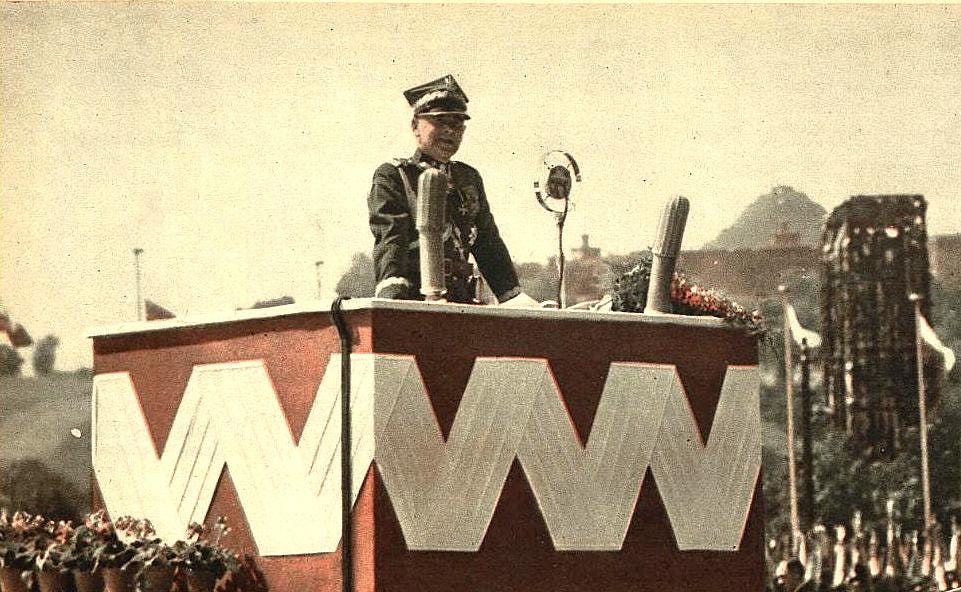
The historical erasure of Britain’s involvement in the negotiations that pushed Poland away from any meaningful settlement is common in Western educational curricula. Under Colonel Beck's direction, the Polish government rejected every overture made by Hitler, believing that Britain’s support would guarantee their security in the event of war.
Not only did Poland spur every peace offering and resolution proposal by Germany, but the military dictatorship took an actively hostile stance. On March 23, 1939, Poland issued a threat to Germany by initiating a partial mobilization of its forces, calling up hundreds of thousands of army reservists. The Polish government warned Hitler that not only was his reasonable offer for a Danzig settlement outright rejected, but they were prepared to go to war to prevent the return of Danzig to Germany. Despite this aggressive stance, the Poles were surprised to find that Germany did not take their challenge seriously. Hitler, who strongly desired a friendly relationship with Poland, decided not to respond to the threat of war. Germany refrained from making any counter-threats or taking any precautionary military measures in reaction to the Polish mobilization.
In the months leading up to the conflict, Polish atrocities against ethnic Germans never subsided but only increased. As tensions mounted between Germany and Poland, the Polish government’s policies became more aggressive, and the violence against the German minority intensified. In the weeks before September 1, 1939, ethnic Germans in Poland faced organized attacks, harassment, and murder, especially in regions like West Prussia, Posen, and Upper Silesia. The crescendo of these attacks was indicative of the deteriorating situation, with anti-German sentiment encouraged by Polish officials and nationalist groups.
In the summer of 1939, Polish civilians and military personnel openly threatened Germans with extermination. On multiple occasions, Germans were arrested without any charges, beaten, and sometimes murdered. A young German man named Gerhard Grieger expressed his growing fear just days before his death: "I have a terrible feeling, I feel as though I am being perpetually watched, and think it would be the best thing to clear out." Grieger was murdered soon after, one of many German civilians caught in the wave of escalating violence.
These atrocities, far from being isolated incidents, reflected a broader climate of violence and persecution that had been growing throughout the 1930s. German families were terrorized in their homes, and targeted by mobs and soldiers alike. Some 80,000 ethnic Germans of an estimated 1.2 million residing in Danzig and Polish territory fled west to Germany for safety and protection in 1939 alone. Many had lost their homes to “expropriation” of land and property by the Polish Government, which paid an eighth of the value and specifically targeted the land of ethnic Germans.
By August 1939, the tension had reached an unbearable level. The British were aware of the detailed violence and targeting of ethnic Germans and the precarious situation and made every effort to keep the temperature of hostilities against Germany elevated. On August 24, 1939, British Ambassador Nevile Henderson in Berlin warned Foreign Secretary Halifax about the dire situation, emphasizing that German complaints of Polish aggression were well-founded. Henderson stressed that war between Poland and Germany was inevitable unless negotiations resumed and Britain actively criticized and condemned Polish actions. However, Henderson was unaware that Halifax sought war as a policy tool, and by some historical accounts was aiming for the total destruction of Germany as early as 1936.
The following day, August 25, 1939, Henderson reported to Halifax about a Polish atrocity in Bielitz, Upper Silesia, where eight Germans were murdered, and many were injured during forced deportations to the center of Poland. Henderson, relying on neutral sources, feared this incident might push Hitler to invade Poland. He recognized Hitler's dilemma—doing nothing would abandon Germans in Poland and the city of Danzig to further violence while taking action could provoke Britain and France into declaring war. Henderson, who desired peace, lamented the British government's failure to restrain Polish authorities.
British diplomat Roy Denman called the war guarantee to Poland “the most reckless undertaking ever given by a British government. It placed the decision on peace or war in Europe in the hands of a reckless, intransigent, swashbuckling military dictatorship.” American historian Richard M. Watt wrote of Britain’s unilateral guarantee to Poland, “For Britain to give such a blank check to a Central European nation, particularly to Poland—a nation that Britain had generally regarded as irresponsible and greedy—was mind-boggling.” No foreign policy as wreckless and misguided as the guarantees Britain made to Poland in 1939 had ever been made to any foreign nation in the entire history of the British Empire. Given Hitler’s many offerings at peace and resolution, the British ‘black cheque’ did nothing less than perhaps serve the purpose for which it was meant—to guarantee another World War.
Once Germany invaded, it became a green light for Polish civilians and military personnel, with the full endorsement of their government, to terrorize the German population. On September 3, 1939, one of the most horrific incidents unfolded in Bromberg (Bydgoszcz), often referred to as "Bloody Sunday." According to German estimates, approximately 7,000 ethnic Germans were killed by Polish civilians and soldiers in a brutal and coordinated attack.
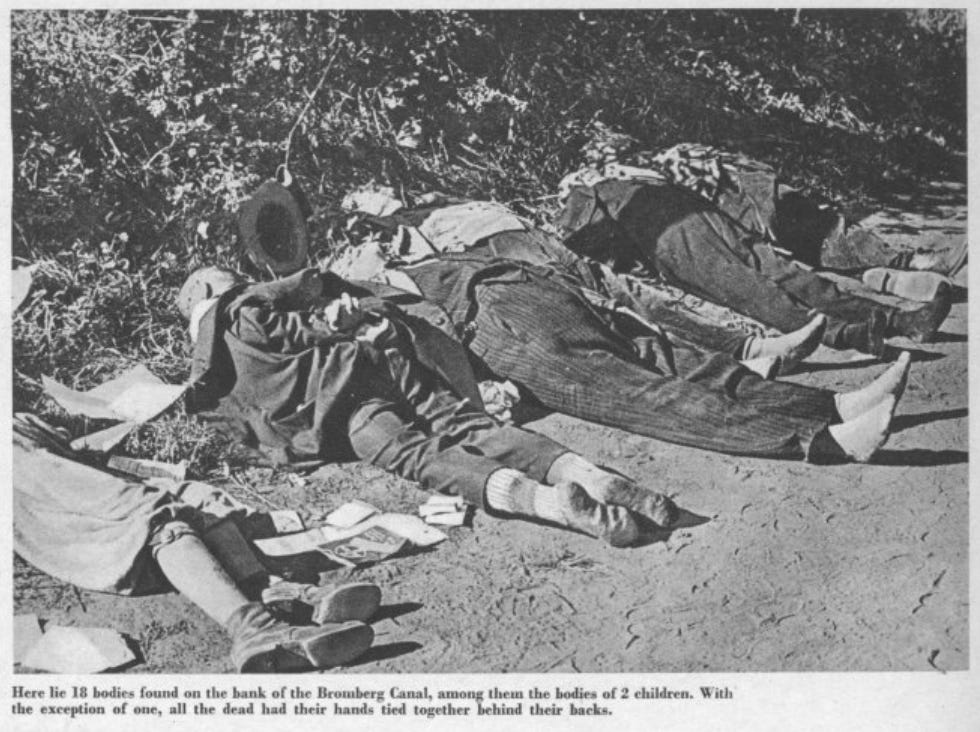
Dorothea Radler, a 14-year-old girl, witnessed the brutal murder of her family at the hands of Polish soldiers. Polish troops arrived at the Radler household and forcibly removed her brother Fritz, aged 19. Moments later, a gunshot rang out, and Fritz’s lifeless body was found nearby. When her father, Artur Radler, rushed outside to help, he was driven back into the house by a Polish officer, who struck him with a whip and threatened him. The following day, September 4, the soldiers returned and shot Dorothea’s younger brother, Heinz, as he attempted to flee into the garden. Heinz was shot twice, once through the head. The soldiers then turned their attention to Artur. They shot him in the throat, leaving a gaping wound. He lived for another five agonizing hours, during which the soldiers refused him any aid. When Artur begged them to end his suffering with a bullet, they cruelly mocked him, telling him, "You can lie there and rot!" The crowd jeered as he lay dying. Finally, one soldier took pity and shot Artur through the temple, ending his agony.
On the same day in Bromberg Charlotte Korth, a widow, testified about the brutal death of her husband, Max Korth. Max, a former German officer in World War I, had hidden in the air-raid shelter of a Polish house, hoping to evade capture. Unfortunately, the Polish owner, Sionon Janek, betrayed him by pointing him out to soldiers. Max was dragged out into the street, where he was bayoneted in the temple. Charlotte later found her husband’s mutilated body lying in the street.
On September 4, 1939, at the Jesuitersee, just south of Bromberg, a large group of German men, including Gustav Gruhl and Leo Reinhard, were rounded up by Polish soldiers and led to the site of their execution. Although Gruhl and Reinhard managed to escape and survive, thirty-nine other ethnic Germans were shot and killed by Polish forces. The executions were carried out without trial, and the men were left to die in the fields. Many of these victims were found days or weeks later, their bodies mutilated, often having been tortured before death.
After Germany steamrolled into Poland, inquiries began into these atrocities as eyewitnesses and survivors came forward. At several POW camps set up for Polish military personnel in East Prussia, the Germans conducted investigations, searching for Poles suspected of being involved in the so-called “Bydgoszcz Bloody Sunday.” The investigation led to the summary execution of 50 soldiers of the Polish Bydgoszcz National Defence Battalion on September 22nd, 1939. To this day the Polish government considers these executions as evidence of German war crimes against Poland during and after the invasion.
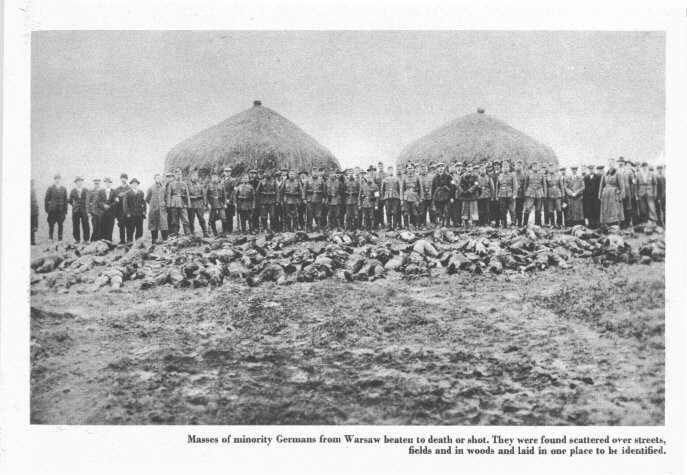
Britain and France’s guarantees to Poland in 1939 placed the nation in a precarious position, emboldening its leadership to reject Hitler’s diplomatic offers regarding Danzig and the Polish Corridor. Confident in Western support, Poland adopted a hardline stance and intensified its persecution of ethnic Germans, believing that Britain and France would defend it in the event of a conflict. Britain and France used Poland as a pawn in their larger strategy to provoke a war with Germany, knowing that Poland alone could not stand against Hitler’s forces.
When Germany invaded on September 1, 1939, the Western powers declared war, but their promises of aid to Poland were hollow. Britain and France provided little direct assistance during the invasion, leaving Poland overrun. Poland caught between German ambitions and the Western desire to confront Hitler on their terms, became the victim of a calculated geopolitical strategy. The guarantees from Britain and France were designed more to bait Hitler into war than to protect Poland, ultimately sacrificing the nation in the early stages of World War II.
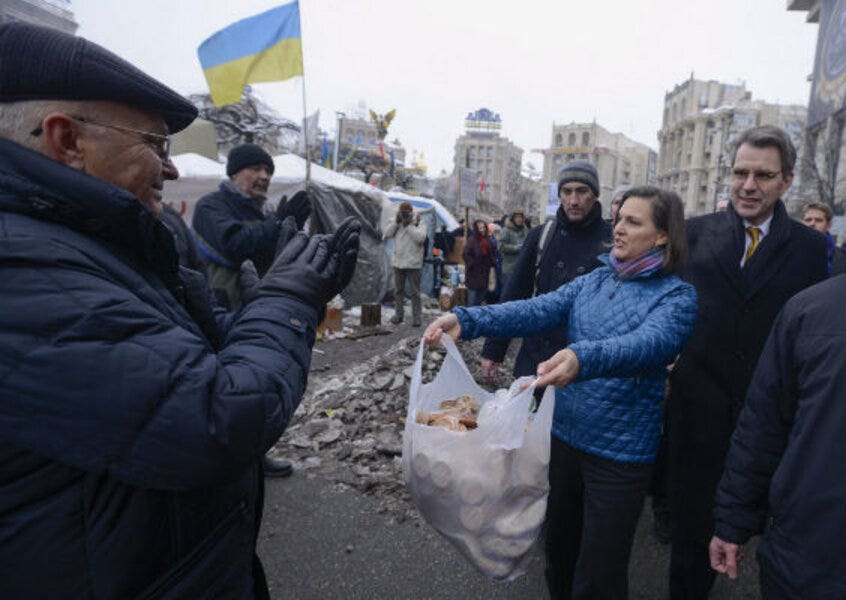
In a stark example of history repeating itself, the events in Ukraine from 2014 to the present echo the tragic precedents set in 1930s Poland with the Danzig Corridor crisis, where media propaganda, ethnic persecution, and geopolitical maneuvering laid the groundwork for conflict. Just as Polish leaders, encouraged by Western powers, victimized and oppressed their ethnic German population in the Danzig Corridor, Ukraine—with significant backing from the United States—launched an aggressive campaign against its ethnic Russian citizens following the Maidan coup.
In 2014, the Maidan uprising, which resulted in the overthrow of President Viktor Yanukovych, was heavily supported by the U.S. government, with American-CIA involvement evident through the rapid emergence of new media outlets like Hromadske TV, Espreso TV, and 1+1 Media Group. Funded by USAID, a State Department front group, and figures like George Soros, these channels became instrumental in spreading anti-Russian propaganda, much like the Polish government in the 1930s used its media to demonize ethnic Germans and provoke tensions with Germany.
This media-driven campaign in Ukraine was aimed at fostering a sense of Ukrainian nationalism, a calculated effort to engineer sentiments against the ethnic Russian community. The government implemented laws restricting the use of the Russian language in schools by 2017, removed Russian textbooks, and eventually made Ukrainian the mandatory language of instruction across all public sectors. This cultural repression mirrored the actions taken by Poland against its German minority, fueling resentment and setting the stage for broader conflict.
The Odessa Trade Unions House massacre on May 2, 2014, wasn’t on the scale of the Bromberg massacre but signified an escalation in separatist warfare. In a scenario reminiscent of the ethnic violence in the Danzig Corridor, pro-Russian demonstrators in Odessa were cornered by Ukrainian nationalists and burned alive in a fire that claimed 48 lives and injured 120 others. This atrocity, sent a clear message of intolerance and retribution, further deepening the divide between the Ukrainian state and its Russian-speaking citizens.
Just as the Polish government's actions in the Danzig Corridor provided Hitler with the pretext for his invasion, Ukraine's suppression of its ethnic Russian population—amplified by media propaganda and supported by NATO's eastward expansion—played into Russia and Putin’s ‘red line’ narratives and justified its military interventions in Donbas and Crimea.
In the aftermath of its separation from normalized relations with Russia, the Ukrainian government intensified efforts to erase Russian cultural and linguistic influence. In January 2015, it passed a law banning Communist and Soviet symbols, removing monuments and symbols significant to the ethnic Russian community. This assault on Russian identity continued with the September 2017 education law, which limited the Russian language in schools, making Ukrainian the dominant language of instruction.
From 2021 to 2023, Ukraine's measures against ethnic Russians and the Russian Orthodox Church became increasingly draconian. In August 2021, the Ukrainian government began an intensified crackdown on political parties perceived as pro-Russian, silencing the "Opposition Platform – For Life" party under accusations of undermining the state's sovereignty. This purge of political dissent left the ethnic Russian population without a voice in the political sphere.
The situation reached a critical point in February 2022 with Russia's full-scale invasion of Ukraine. In response, the Ukrainian government intensified its repression. In April 2022, authorities banned the activities of the Russian Orthodox Church, particularly targeting institutions linked to the Moscow Patriarchate. Churches were seized, and religious figures were silenced, further alienating the Russian Orthodox community.
May 2022 saw the enforcement of laws that effectively banished the Russian language from public life. Education, media, and government services were purged of Russian, completing the cultural erasure of the Russian-speaking population. In March 2023, new laws were passed to further suppress the influence of Russian-aligned churches and clergy, cutting the remaining ties to Moscow. By July 2023, Ukraine had imposed harsh restrictions on Russian media outlets and cultural organizations, eradicating Russian symbols and content, and leaving no trace of Russian influence in Ukrainian society.
Just as with Germany and Poland, any attempts at brokering a peace agreement between Russia and Ukraine have been hampered by British and American desires to keep the conflict raging at all costs.
As with the origins of World War Two, the Western alliance of the so-called “liberal rules-based order” would have their populations believe that Russia was the aggressor against Ukraine for ‘no reason at all,’ just as Germany invaded Poland for ‘no reason at all,’ and Putin like Hitler before him is some kind of a maniacal dictator with intentions of conquering neighboring countries, for ‘no reason at all.’
However, as we have just explored, there are significant reasons— one could argue understandable motivations for the invasion of Poland and Ukraine. To accept there was 'no reason at all’ would demonstrate a complete ignorance of the historical facts.
Watch Notes From The Past’s short documentary of this essay here:
References
Hoggan, David L., The Forced War: When Peaceful Revision Failed, Costa Mesa, Cal.: Institute for Historical Review, 1989.
Irving, David, Hitler’s War, London, Hodder & Stoughton, 1977.
Taylor, A.J.P., The Origins of the Second World War, New York: Simon & Schuster, 1961.
Shadewalt, Hans, Polish Atrocities against the German Minority in Poland, Berlin and New York: German Library of Information, 1940.
Who Started WWII? Real History Series #1.
Hargreaves, Richard, Blitzkrieg Unleashed: The German Invasion of Poland 1939, South Yorkshire: Pen and Sword Books, 2008.
They Lied About Everything
Fixed Income Pensioner Discount (honor system)
Student Discount (valid .edu email)
Thank you for sharing
The Good Citizen is now on Ko-Fi. Support more works like this with one-time or monthly donations.
Visit shop.thegoodcitizen.live
Donate
BTC: bc1qchkg507t0qtg27fuccgmrfnau9s3nk4kvgkwk0
LTC: LgQVM7su3dXPCpHLMsARzvVXmky1PMeDwY
XLM: GDC347O6EWCMP7N5ISSXYEL54Z7PNQZYNBQ7RVMJMFMAVT6HUNSVIP64
DASH: XtxYWFuUKPbz6eQbpQNP8As6Uxm968R9nu
XMR: 42ESfh5mdZ5f5vryjRjRzkEYWVnY7uGaaD


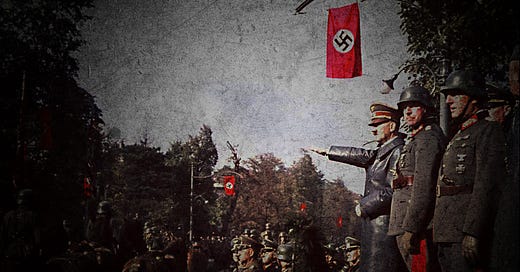





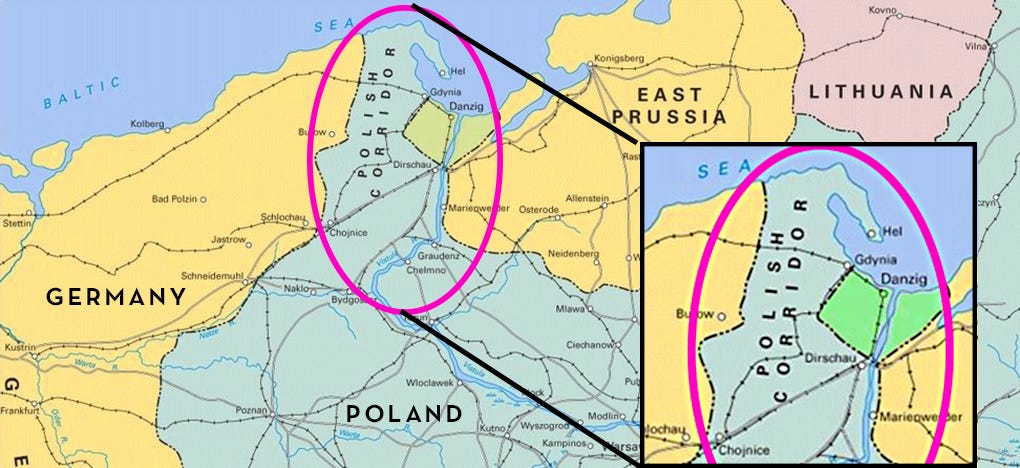
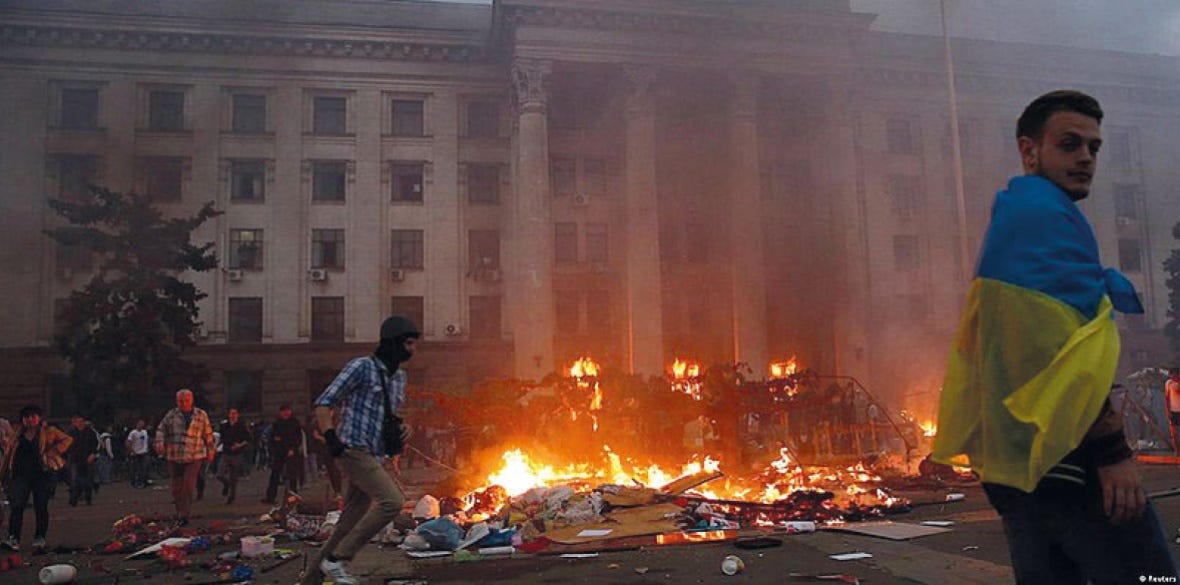


Too many people still do not know this tragic story, but only know the lies of the victors. My relatives suffered the assault against Germany. But now some are so brainwashed that they believe the victor's lies.
Nice job GC - We often know our history from just one, rather myopic, perspective. Thanks for the broader perspective!